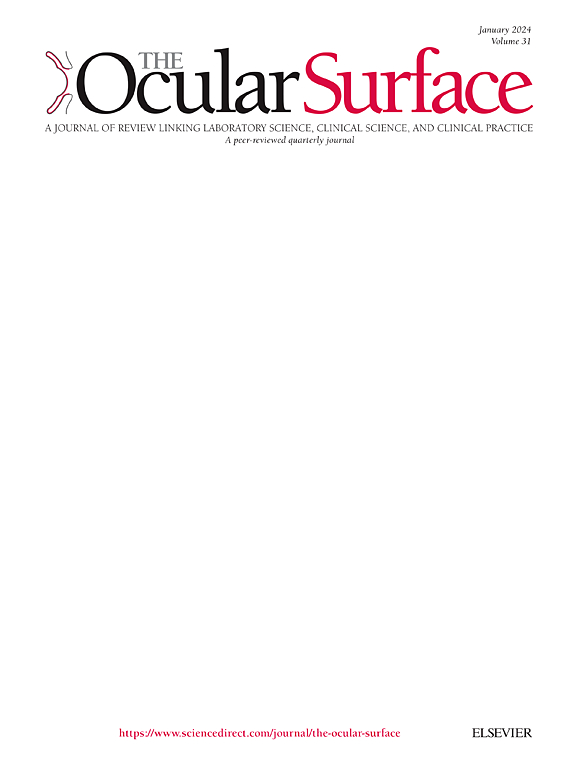Transcriptional landscape of aniridia-associated keratopathy through single-cell RNA sequencing
IF 5.6
1区 医学
Q1 OPHTHALMOLOGY
引用次数: 0
Abstract
Purpose
Aniridia-associated keratopathy (AAK) is a progressive condition characterized by conjunctivalization of the cornea, yet its molecular mechanisms remain largely unknown. This study aims to elucidate the transcriptional landscape of AAK by characterizing the gene expression profiles of corneal epithelial cells in a patient with congenital aniridia.
Methods
Single-cell RNA sequencing (scRNA-seq) was performed on epithelial tissues collected from the clear central corneal region and limbus of a 48-year-old female patient with congenital aniridia. The transcriptomic profiles were compared with those of healthy control samples.
Results
scRNA-seq analysis revealed that a subpopulation of cells from the clear central corneal region expressed the cornea-specific keratins KRT3 and KRT12 despite a significant reduction in PAX6 expression. These cells exhibited corneal, conjunctival, or mixed gene signatures. Genes associated with wound healing and apoptosis were upregulated in the cornea-like cells from the aniridic cornea, indicating a chronic wound healing state. Elevated KLF4 expression and regulon activity were observed in these cornea-like cells. Most limbal epithelial cells exhibited conjunctiva-like characteristics, reflecting a loss of limbal cell identity.
Conclusion
While acknowledging the limitations of a single case study, this study provides deeper insights into the transcriptional signatures associated with AAK using scRNA-seq. We identified transcriptional alterations reflecting AAK progression and highlighted potential transcription factors that may contribute to corneal identity maintenance despite PAX6 deficiency. These findings enhance our understanding of AAK and suggest potential therapeutic strategies to slow its progression.
通过单细胞RNA测序研究无虹膜相关性角膜病变的转录景观
目的无虹膜相关性角膜病变(AAK)是一种以角膜结膜炎为特征的进行性疾病,其分子机制在很大程度上仍不清楚。本研究旨在通过表征先天性无虹膜患者角膜上皮细胞的基因表达谱来阐明AAK的转录景观。方法对48岁女性先天性无虹膜患者角膜中央透明区及角膜缘上皮组织进行单细胞RNA测序(scRNA-seq)。将转录组谱与健康对照样本进行比较。结果scrna -seq分析显示,尽管PAX6表达显著降低,但来自角膜中央区域的一个细胞亚群表达了角膜特异性角蛋白KRT3和KRT12。这些细胞表现出角膜、结膜或混合基因特征。无角膜样角膜细胞中与伤口愈合和凋亡相关的基因上调,表明伤口愈合处于慢性状态。在这些角膜样细胞中观察到KLF4表达和调控蛋白活性升高。大多数角膜缘上皮细胞表现出结膜样特征,反映了角膜缘细胞身份的丧失。虽然承认单个案例研究的局限性,但本研究使用scRNA-seq对与AAK相关的转录特征提供了更深入的了解。我们发现了反映AAK进展的转录改变,并强调了尽管PAX6缺乏,但可能有助于角膜身份维持的潜在转录因子。这些发现增强了我们对AAK的理解,并提出了减缓其进展的潜在治疗策略。
本文章由计算机程序翻译,如有差异,请以英文原文为准。
求助全文
约1分钟内获得全文
求助全文
来源期刊

Ocular Surface
医学-眼科学
CiteScore
11.60
自引率
14.10%
发文量
97
审稿时长
39 days
期刊介绍:
The Ocular Surface, a quarterly, a peer-reviewed journal, is an authoritative resource that integrates and interprets major findings in diverse fields related to the ocular surface, including ophthalmology, optometry, genetics, molecular biology, pharmacology, immunology, infectious disease, and epidemiology. Its critical review articles cover the most current knowledge on medical and surgical management of ocular surface pathology, new understandings of ocular surface physiology, the meaning of recent discoveries on how the ocular surface responds to injury and disease, and updates on drug and device development. The journal also publishes select original research reports and articles describing cutting-edge techniques and technology in the field.
Benefits to authors
We also provide many author benefits, such as free PDFs, a liberal copyright policy, special discounts on Elsevier publications and much more. Please click here for more information on our author services.
Please see our Guide for Authors for information on article submission. If you require any further information or help, please visit our Support Center
 求助内容:
求助内容: 应助结果提醒方式:
应助结果提醒方式:


